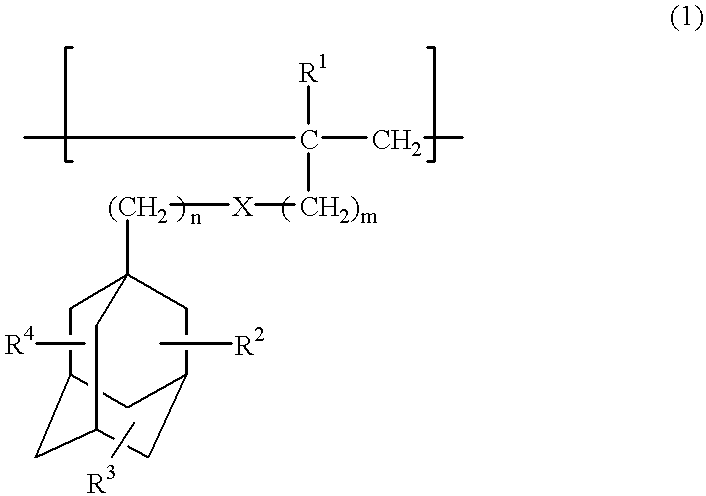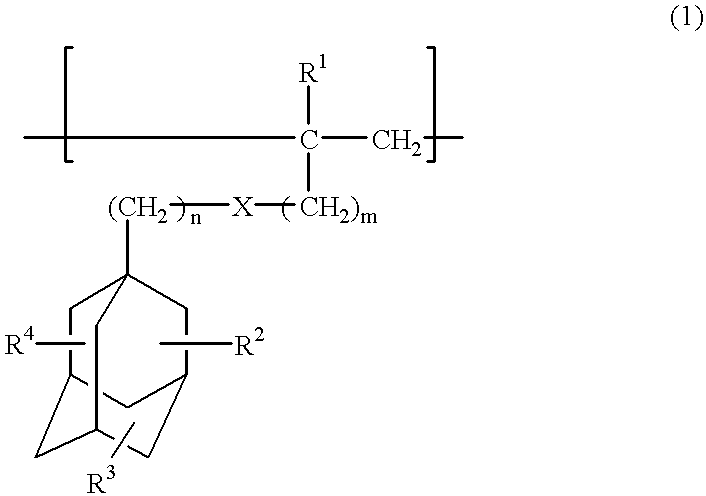Compounds for photoresist and resin composition for photoresist
- Summary
- Abstract
- Description
- Claims
- Application Information
AI Technical Summary
Benefits of technology
Problems solved by technology
Method used
Image
Examples
example 1
(1) Hydroxylation
A mixture of 10 mmol of adamantane, 2 mmol of N-hydroxyphthalimide (NHPI), 0.1 mmol of vanadiumacetylacetonato V(AA).sub.3 and 25 ml of acetic acid was stirred in an atmosphere of oxygen at 85.degree. C. for 10 hours, and there were formed, with a conversion of adamantane of 99%, 1-adamantanol (yield: 8%), 1,3-adamantanediol (yield: 22%), 1,3,5-adamantanetriol (yield: 33%), and 1,3,5,7-adamantanetetraol (yield: 20%).
(2) Introduction of an Acryloyl Group and a Protective Group
10 mmol of 1,3,5-adamantanetriol, 10 mmol of triethylamine, and 40 ml of tetrahydrofuran were mixed, and 10 mmol of acrylic acid chloride was added dropwise to this mixture for about 30 minutes. After completion of the dropwise addition, the mixture was stirred at room temperature for 6 hours. After the reaction had been completed, to the reaction mixture was added water and the resultant mixture was purified by column chromatography to give 1-acryloyloxy-3,5-dihydroxyadamantane.
To 30 ml of tetr...
example 2
10 mmol of 1,3,5-adamantanetriol, 10 mmol of triethylamine, and 40 ml of tetrahydrofuran were mixed, and 10 mmol of methacrylic acid chloride was added dropwise to the mixture for about 30 minutes. After completion of the dropwise addition, the mixture was stirred at room temperature for 24 hours. After the reaction had been completed, to the reaction mixture was added water, followed by purification by column chromatography to give 1-methacryloyloxy-3,5-dihydroxyadamantane.
To 30 ml of tetrahydrofuran were added 5 mmol of 1-methacryloyloxy-3,5-dihydroxyadamantane, 15 mmol of acetoaldehyde, and 1 mmol of p-toluenesulfonic acid, and the mixture was stirred at 30.degree. C. for 6 hours. The reaction mixture was condensed under acidic conditions and crystallized by adding to diethyl ether dropwise to give the object compound 1-methacryloyloxy-3,5-di(1-hydroxyethoxy)adamantane (acetal compound) represented by the following formula: ##STR13##
Except for the use of the obtained 1-methacrylo...
example 3
(1) Carboxylation
10 mmol of 1,3,5-adamantanetriol, 1 mmol of NHPI, 0.005 mmol of Co(AA).sub.2 were added to 25 ml of acetic acid, and the mixture was stirred at 60.degree. C. for 6 hours in a reactor with a gas pack inflated with a mixed gas (mixed gas: 2 L of carbon monoxide adn 0.5 L of oxygen; pressure: 5 kg / cm.sup.2) connected thereto. As a result, with a conversion of 1,3,5-adamantanetriol of 99%, there was obtained 1-carboxy-3,5,7-adamantanetriol (yield: 80%).
(2) Esterification and Introduction of a Protective Group
1 mmol of 1-carboxy-3,5,7-adamantanetriol and 2.5 mmol of 2-hydroxyethyl acrylate were reacted in toluene to give 1-acryloyloxyethoxycarbonyl-3,5,7-adamantanetriol. To 30 ml of tetrahydrofuran were added 5 mmol of 1-acryloyloxyethoxycarbonyl-3,5,7-adamantanetriol, 25 mmol of acetoaldehyde, and 1 mmol of p-toluenesulfonic acid, and the mixture was acetalized in the same manner as in Example 1 to give the object compound 1-acryloyloxyethoxycarbonyl-3,5,7-tri(1-hydroxy...
PUM
| Property | Measurement | Unit |
|---|---|---|
| Percent by mass | aaaaa | aaaaa |
| Percent by mass | aaaaa | aaaaa |
| Weight | aaaaa | aaaaa |
Abstract
Description
Claims
Application Information
 Login to View More
Login to View More - R&D
- Intellectual Property
- Life Sciences
- Materials
- Tech Scout
- Unparalleled Data Quality
- Higher Quality Content
- 60% Fewer Hallucinations
Browse by: Latest US Patents, China's latest patents, Technical Efficacy Thesaurus, Application Domain, Technology Topic, Popular Technical Reports.
© 2025 PatSnap. All rights reserved.Legal|Privacy policy|Modern Slavery Act Transparency Statement|Sitemap|About US| Contact US: help@patsnap.com



